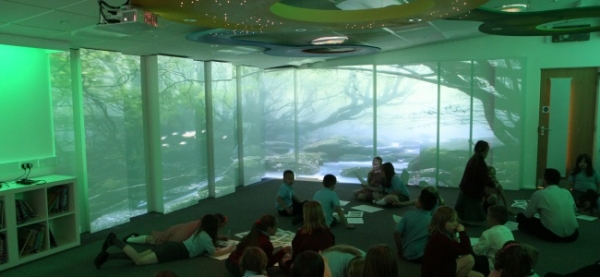It’s my opinion that everybody has a skill or experience that they are good at, that they can be absorbed by, and that they can learn from, whether that exists within a traditional learning environment or elsewhere. The difficulty is often having the time to find out what that skill is, and creating a flexible, personalised learning environment that can cater to individual needs. Immersive spaces can’t solve the problems of the complex context or history of those children who have, rightly or wrongly, been labelled as ‘unengaged’, but they can provide a forum in which their barriers to learning can be disregarded, and their approaches to enquiry, communication and experience identified and championed.
So how does this work in practice? Huddled in their enormous parachute tent, the Y2 boys at Bowlee Primary school in Middleton are looking at a single red poppy that is trapped in a glowing white box in the middle of the tent. They are asked to write down what they think it is and how it makes them feel, looking at that poppy, hearing the gunfire and being in that space.
For a school that is outstanding across the board, but where children have limited experiences and where engagement within boys’ literacy is an ongoing challenge, providing them with an opportunity to use writing to express their own feelings in their immediate surroundings was powerful. Not only did the children begin writing straight away, using vocabulary and WOW words that the teachers acknowledged was at a richer level than previous work in the classroom, but most also started working together in small groups of two or three, without direction. Taking charge of the way they learned and engaging in an experiential way encouraged them to engage more deeply.
At Ormiston Horizon Academy in Stoke on Trent, they create immersive experiences that blend the vocational with the theoretical, the practical with the abstract to engage pupils in maths and science. By creating experiential scenarios within their immersive environment, pupils must employ their maths knowledge to solve a series of mysteries, from working in a Criminology lab to find out who murdered the Y9 maths teacher, to exploring engineering by designing and building balloon cars within the space. So what’s different? In all of these short examples, the immersive experiences created did more than just excite, provoke and enthuse.
On a basic level, they permitted the pupils to travel to worlds – real or otherwise – that most had not had access to before, to experience new sensations, landscapes and scenarios in a safe space. Crucially, they were allowed to experience these environments in their own time, as individuals, without being singled out. With labels disregarded, they could take ownership of their learning by using their own experiences to shape that learning, and teachers in turn could observe the different ways in which pupils processed this journey.
One of the most powerful things a teacher said to me was that in their immersive space, the differences of ability between the pupils in her class became much less apparent. Because each child had the freedom and space to nurture their imagination independently and interpret their experience and their responses to it in a space that belonged as much to them and their peers as to the practitioners supporting their transition through education.
Do you use immersive environments in your school? Share your experiences below.


















